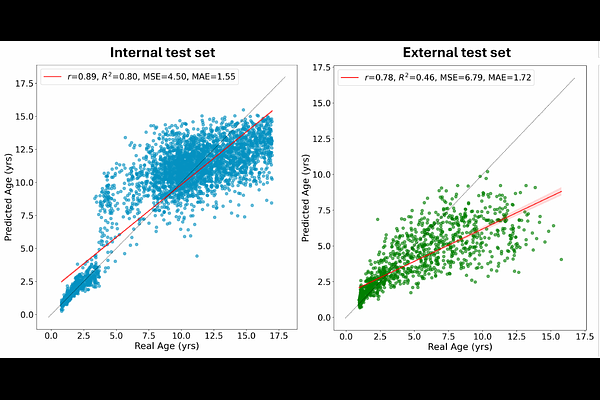BabyPy: a brain-age model for infancy, childhood and adolescence

BabyPy: a brain-age model for infancy, childhood and adolescence
Biondo, F.; O'Muircheartaigh, J.; Bethlehem, R. A. I.; Seidlitz, J.; Alexander-Bloch, A.; Elison, J.; D'Sa, V.; Deoni, S. C. L.; Bruchhage, M. M. K.; Cole, J. H.
AbstractBackground: Brain-age models aim to provide a single metric reflecting overall brain health by estimating an individual's age based on neuroimaging data. Although extensively applied in adults, their use in early development has been limited due to data heterogeneity and model accessibility. Aim: To develop BabyPy, a robust and shareable brain-age model tailored for individuals from infancy to adolescence, capable of accurate predictions despite heterogeneity in age, study, and preprocessing differences Methods: A total of 4,021 structural T1-weighted MRI scans from individuals aged 0-17 years were used for training, sourced from collaborative multi-site datasets. An external test set of 1,143 scans (ages 0-16 years) was used for validation. Coarse neuroimaging features, grey matter volume (GMV), white matter volume (WMV), and subcortical grey matter volume (sGMV), were used. An ensemble machine learning approach was employed, combining Extra Trees Regression, Support Vector Machine, and Multilayer Perceptron base models. Model performance was evaluated via 5-fold cross-validation and external testing. Results: The ensemble meta-model explained 80% of the variance in age (training set, MAE = 1.55 years) and 46% of the variance in the external test set (MAE = 1.72 years). Conclusion: BabyPy is a shareable framework that estimates brain-age across a broad developmental range without requiring separate models. Despite limitations due to data heterogeneity, it demonstrates robust predictive performance and facilitates cross-study comparisons. Future improvements in harmonisation will further enhance the utility of generic brain-age models like BabyPy.